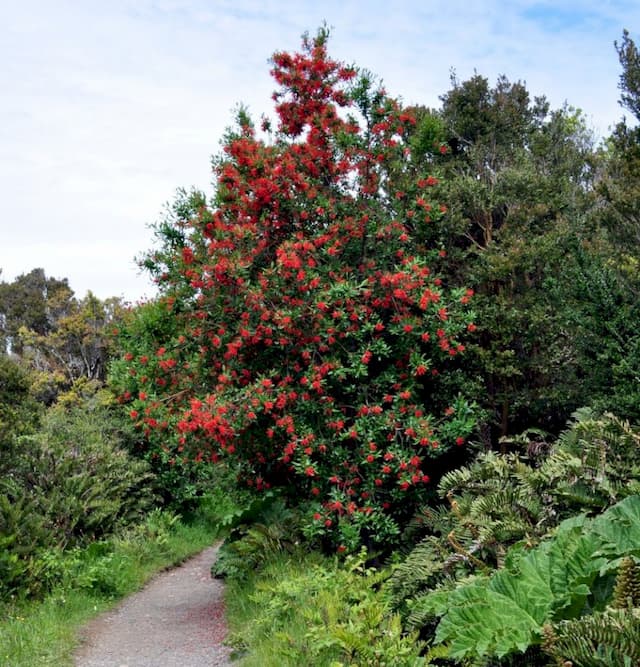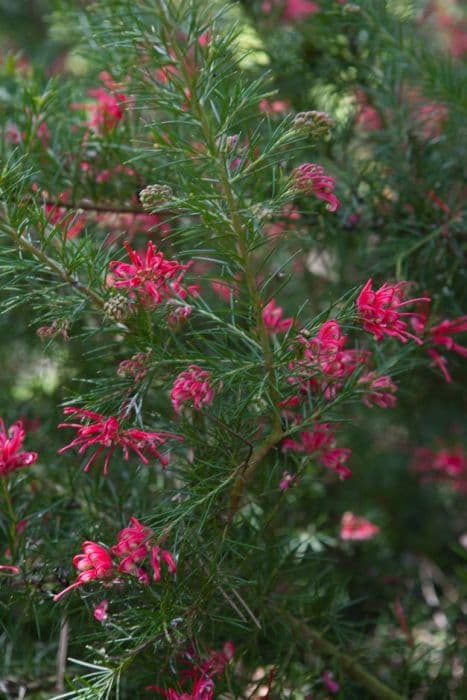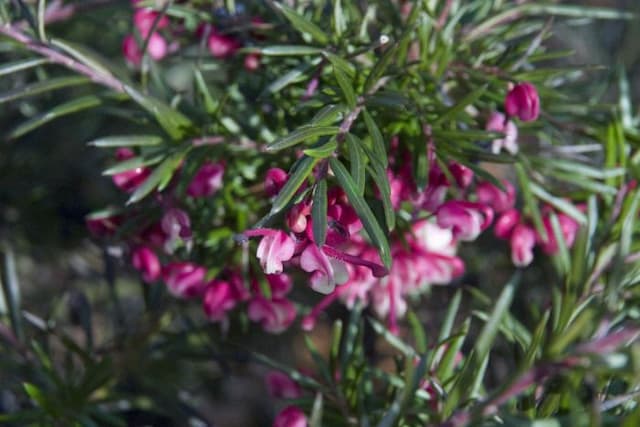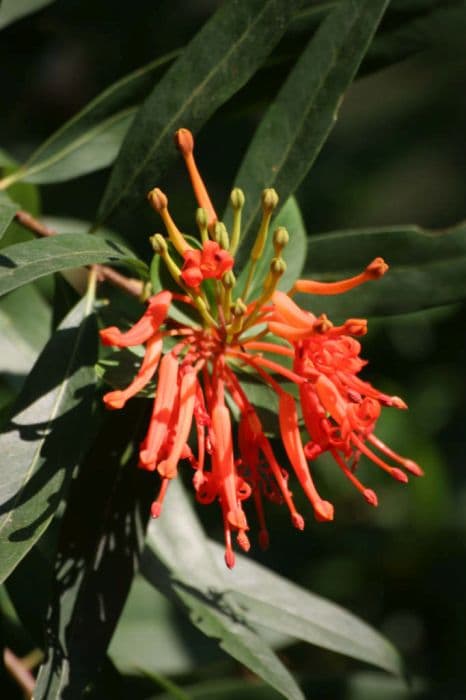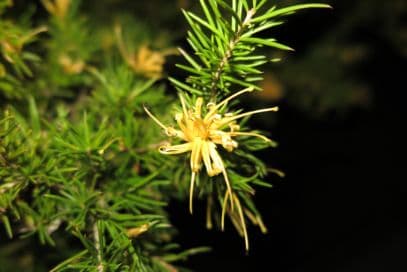Hairpin Banksia Banksia spinulosa 'Birthday Candles'

ABOUT
Birthday Candles is a captivating plant loved for its distinctive appearance. This eye-catching plant has a dense, bushy habit, showcasing an impressive display of golden-to-orange cylindrical flower spikes. These spikes resemble candles, which is how the plant gets its celebratory name. The flower structures are tipped with intriguing styles that can range in color from reddish to black, adding to their ornamental value. This plant's foliage is an attractive dark green hue, providing a lush backdrop for the colorful blooms. The leaves are narrow to oblong in shape and have a slightly serrated edge, giving them a textured look and feel. These leaves create a striking contrast against the brilliant flower spikes. Birthday Candles produces an abundant bloom display that tends to peak in the cooler months, providing a cheerful burst of color in the garden when many other plants are dormant. The flowers are not only visually appealing but also attract a variety of native wildlife, including birds and bees, which come to feed on the nectar. Overall, the plant carries a unique charm with its combination of vivid flower spikes and rich green foliage, making it a sought-after addition to gardens and landscapes. Whether planted as a standalone feature or as part of a mixed border, Birthday Candles brings a touch of festivity and natural beauty to any setting.
About this plant
 Names
NamesSynonyms
Hairpin Banksia, Birthday Candles Banksia, Bush Candles, Cushion Banksia.
Common names
Banksia spinulosa 'Birthday Candles'.
 Toxicity
ToxicityTo humans
The Hairpin Banksia is not commonly known to be toxic to humans. There are no widely recognized symptoms of poisoning because this plant is generally not considered to be poisonous if parts are accidentally ingested. As with any plant material, individuals may experience different reactions and it's sensible to remain cautious and avoid ingesting plant material that is not generally recognized as edible.
To pets
The Hairpin Banksia is not known to be toxic to pets either. It doesn't have a reputation for causing poisoning if pets happen to ingest parts of the plant. However, as pets can have individual responses to plant materials, it is always best to monitor your pet for any unusual reactions after ingesting any part of a plant and consult a veterinarian if any adverse symptoms are observed.
 Characteristics
CharacteristicsLife cycle
Perennials
Foliage type
Evergreen
Color of leaves
Green
Flower color
Yellow
Height
2 feet (0.6 meters)
Spread
3 feet (0.9 meters)
Plant type
Shrub
Hardiness zones
9
Native area
Australia
Benefits
 General Benefits
General Benefits- Attractive Aesthetics: Banksia 'Birthday Candles' has vibrant orange-yellow flower spikes and dense foliage, adding visual appeal to gardens.
- Drought Resistance: Once established, it is highly tolerant of dry conditions, reducing the need for frequent watering.
- Wildlife Attraction: The flowers produce abundant nectar, attracting nectar-feeding birds and beneficial insects to the garden.
- Low Maintenance: This hardy shrub requires minimal care once established, making it ideal for busy gardeners.
- Coastal Tolerance: Banksia 'Birthday Candles' can thrive in coastal conditions, including sandy soils and salt spray.
- Compact Size: The dwarf cultivar is well-suited for small gardens or as a container plant due to its compact growth habit.
- Year-Round Interest: With its evergreen leaves and long flowering season, it provides interest throughout the year.
- Erosion Control: The plant's dense root system helps stabilize soil, preventing soil erosion on slopes.
- Cultural Significance: Banksias have importance in Australian culture and can contribute to indigenous-inspired garden designs.
- Versatility: It can be used in a variety of landscaping applications, including rockeries, borders, and as ground cover.
 Medical Properties
Medical PropertiesThis plant is not used for medical purposes.
 Air-purifying Qualities
Air-purifying QualitiesThis plant is not specifically known for air purifying qualities.
 Other Uses
Other Uses- Natural Dyes: The flowers of Banksia 'Birthday Candles' can be used to produce natural dyes for fabrics, yielding colors that often reflect the hues of the flowers.
- Floral Arrangements: With their unique shape and texture, the blooms and seed pods can be added to dried floral arrangements for an exotic touch.
- Craft Materials: Seed pods may be used in various crafts and as adornments in decorative pieces due to their interesting shapes and textures.
- Sand Erosion Control: As a native Australian plant, Banksia 'Birthday Candles' can be planted to help stabilize sand dunes and control erosion in coastal areas.
- Education: The plant offers an opportunity for students and gardeners to learn about Australia’s unique flora and the importance of conserving it.
- Wildlife Habitat: Planting Banksia 'Birthday Candles' provides shelter and food for native bees, birds, and other wildlife in gardens and landscapes.
- Biofuel Research: Banksias produce abundant biomass which could potentially be used in the research of renewable energy sources and biofuels.
- Winter Garden Interest: Its evergreen foliage and distinct flowers make it ideal for adding color and texture to gardens during the dull winter months.
- Photography: The striking appearance of 'Birthday Candles' offers a stunning subject for photographers, particularly those focusing on botanical subjects.
- Soil Improvement: Banksia 'Birthday Candles', like other Banksias, are known to improve soil quality over time due to their relationship with soil microbes and their nutrient-rich leaf litter decomposition.
Interesting Facts
 Feng Shui
Feng ShuiThe Banksia is not used in Feng Shui practice.
 Zodiac Sign Compitability
Zodiac Sign CompitabilityThe Banksia is not used in astrology practice.
 Plant Symbolism
Plant Symbolism- Resilience and Survival: The Banksia is well known for its ability to survive in difficult environments, symbolizing the power of perseverance and resilience.
- Rebirth and Renewal: It has the ability to regenerate after fires, which stands for rebirth and the possibility of new beginnings.
- Protection: With its tough exterior, the Banksia represents a natural form of protection and is often seen as a symbol of safeguarding oneself or others.
- Uniqueness and Individuality: The distinctive flowers and cones of the Banksia highlight the importance of embracing one's uniqueness.
- Adaptability: As the Banksia is adaptable to various soil types and climates, it embodies the ability to thrive in diverse conditions and adapt to change.
 Water
WaterThe Birthday Candles Banksia requires moderate watering, usually about 1 inch per week. During hot, dry periods, water thoroughly to moisten the soil to a depth of 8 to 10 inches every two weeks. They prefer to dry out slightly between waterings, so ensure the soil is not constantly wet. Overwatering can damage the plant's health. It's best to water the plant early in the morning to allow the foliage time to dry before evening.
 Light
LightBirthday Candles Banksia thrives in full sun but can tolerate partial shade. Plant it in a location where it will receive at least 6 to 8 hours of direct sunlight each day. Avoid deep shade, as insufficient light can lead to poor flowering and leggy growth. Good exposure to sunlight supports the best health and flowering in this shrub.
 Temperature
TemperatureThe ideal growing temperatures for Birthday Candles Banksia are between 50°F and 70°F. They are hardy and can survive minimum temperatures down to about 20°F, but they should be protected from frost. These plants can withstand high temperatures but may require additional watering in extreme heat.
 Pruning
PruningPruning Birthday Candles Banksia is essential to maintain its shape and encourage more prolific flowering. It should be pruned right after the flowers have faded, typically late spring or early summer. Remove spent flower spikes and lightly shape the plant, cutting back any unruly or long shoots to promote bushiness. Avoid heavy pruning, which can damage the plant.
 Cleaning
CleaningAs needed
 Soil
SoilBirthday Candles Banksia prefers well-drained, sandy loam soil with a slight acidic to neutral pH of around 5.5 to 6.5. The best soil mix for this dwarf banksia is a combination of equal parts sand, loam, and peat moss or well-rotted compost to ensure good drainage and aeration. Regularly test the soil pH to maintain the desired acidity, and amend with sulfur if it becomes too alkaline. Avoid heavy, clay-based soils which retain moisture, as poor drainage can lead to root rot.
 Repotting
RepottingBirthday Candles Banksia is a slow-growing plant and does not need to be repotted frequently. It typically requires repotting every 2 to 3 years. Choose a pot only slightly larger than the previous one to avoid overly damp soil which can promote root rot. The best time to repot is in the late winter or early spring before new growth begins. Ensure the new pot has adequate drainage holes.
 Humidity & Misting
Humidity & MistingBirthday Candles Banksia is tolerant of a range of humidity conditions but thrives best in moderate to low humidity environments. Native to Australia, this dwarf banksia is adapted to dry conditions and does not require high humidity levels. Indoor air is usually sufficient for this plant, and no special humidity adjustments are necessary. Avoid creating overly humid conditions as it may encourage fungal diseases.
 Suitable locations
Suitable locationsIndoor
Place in bright, indirect light, and maintain dry conditions.
Outdoor
Full sun, well-drained soil, protect from severe frosts.
Hardiness zone
9-11 USDA
 Life cycle
Life cycleBanksia spinulosa 'Birthday Candles' begins its life as a seed, which requires exposure to smoke or fire to break its dormancy and initiate germination. Once the seedling emerges, it enters a juvenile growth phase where it develops a deep root system and foliage, without producing flowers. The plant reaches maturity within a few years, during which it develops a woody trunk and starts to flower annually, typically from late summer to winter. Flowers are cylindrical spikes, with styles that start out yellow and age to a rusty red. After pollination, typically involving birds and insects, the flowers develop into follicles that hold the seeds and require another fire event to open and release seeds for the next generation. The plant can live for many years, continuing to grow, flower, and reproduce, while also being able to resprout from its lignotuber after adverse events like fires.
 Propogation
PropogationPropogation time
Late Summer to Autumn
Banksia spinulosa 'Birthday Candles,' commonly known as Dwarf Banksia, can be propagated through seed or cuttings. The most popular method for this cultivar is via cuttings, as seed propagation can often result in plants that are variable and not true to the parent's form. The ideal time to take cuttings is during the summer months when the plant is actively growing. Select semi-hardwood cuttings about 4 to 6 inches (10 to 15 centimeters) in length, ensuring each cutting has at least one node and several leaves. Dip the cut end in rooting hormone powder to encourage root growth and plant it in a well-draining propagation mix. Maintain humidity and keep the soil consistently moist but not waterlogged. Rooting typically occurs within a few months, after which the new plants can be gradually acclimated to less humid conditions and eventually planted out.



